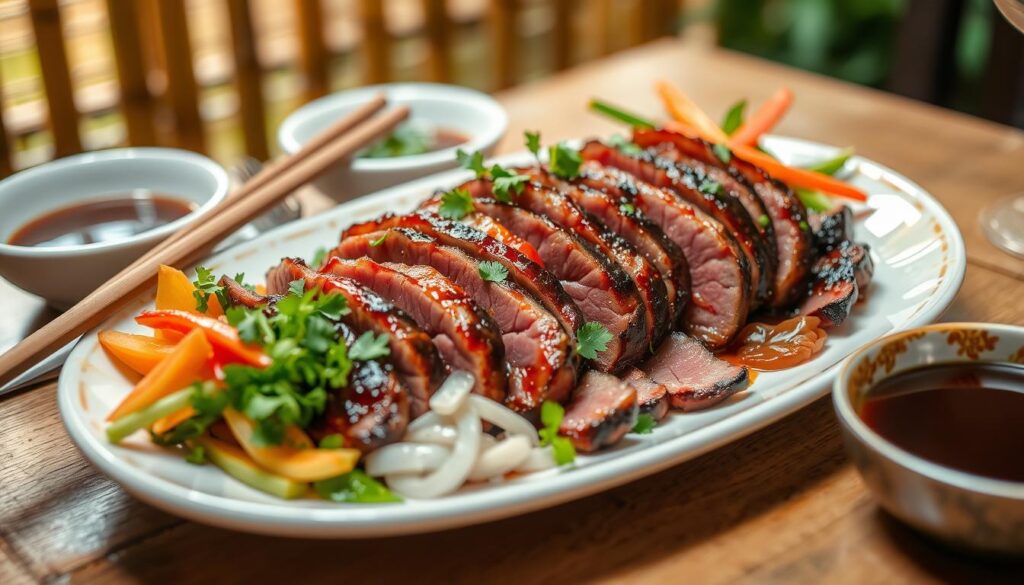As a foodie who loves Asian cuisine, I’ve found the magic in thinly sliced beef. It’s the base for many delicious dishes, like Mongolian Beef and Bo Kho Vietnamese Beef Stew. This beef is key to making quick, 30-minute meals that are as good as takeout.
With the right techniques and tools, you can become a pro at preparing thinly sliced beef. This will take your Asian-inspired meals to a whole new level.
Table of Contents
Understanding Thinly Sliced Beef
Creating delicious Asian-inspired dishes starts with thinly sliced Beef Lunchmeat. This method improves the meat’s texture and taste. It also makes cooking faster and sauce absorption easier. Thinly sliced beef is known as sandwich steak, shabu-shabu beef, and more.
Best Cuts for Thin Slicing
Flank steak and skirt steak are top picks for thin slicing. They offer Protein Slices and are great for Asian dishes. Freezing the meat slightly before slicing makes it tender and flavorful.
Proper Thickness and Cutting Techniques
The perfect thickness for Cold Cuts is 1/4 inch. This ensures quick cooking and flavor absorption. Freeze the beef first, then slice it thinly with a sharp knife, cutting against the grain.
| Cut | Characteristics | Price Point |
|---|---|---|
| Sirloin | Tender with moderate marbling | Mid-range |
| Flank Steak | Lean with robust beefy flavor | Mid-range |
| Skirt Steak | Tender with intense beef flavor | Mid-range |
| Hanger Steak | Tender with a unique flavor profile | Mid-range |
Knowing the names, best cuts, and slicing techniques for thinly sliced beef can enhance your Asian cooking. It helps you make dishes that will wow your guests.
Essential Tools and Equipment for Slicing Beef
To make paper-thin beef slices at home, you need the right tools. This can take your Asian-inspired dishes to the next level. Let’s look at the key equipment for slicing beef easily.
A sharp chef’s knife is crucial for thin beef slices. While a meat slicer gives consistent thin cuts, it’s not for everyone. Freezing the beef slightly helps get thin, even cuts with a regular knife.
A large, strong cutting board is also important. It gives you enough space to work and lets your knife move smoothly. For even thinner slices, use a meat mallet to gently pound the beef.
| Tool | Recommended Product | Average Price |
|---|---|---|
| Chef’s Knife | Wusthof Classic Carving Knife | $170 |
| Slicing Knife | Victorinox Fibrox Pro Slicing Knife | $67 |
| Budget Carving Knife | Best Budget Carving Knife | $41 |
| Carving Knife Set | Wusthof Classic Carving Knife Set | $220 |
| Japanese Slicing Knife | Best Japanese Slicing Knife | $230 |
With the right tools and practice, you’ll be slicing Artisanal Cured Meat and Charcuterie like a pro. The secret is a sharp blade, steady hand, and patience.
Preparing Beef for Asian-Style Dishes
Creating delicious Asian-inspired dishes starts with the right preparation of thinly sliced beef. Marinating the beef is key to enhance flavor and tenderness. Mix soy sauce, brown sugar, minced garlic, and ginger for a simple marinade.
Marinating Techniques
For the best results, marinate the thinly sliced beef for at least 30 minutes. Or, let it marinate for up to 2 hours in the fridge. This allows the flavors to blend and tenderize the meat. Before cooking, bring the beef to room temperature for even cooking.
Seasoning and Tenderizing Methods
To improve the texture of your thinly sliced beef, add a bit of cornstarch to the marinade. This makes the meat silky and velvety. Season with salt, pepper, and spices to add depth to the flavors.
Temperature Considerations
When cooking thinly sliced beef, keep an eye on the temperature. Let the beef warm up to room temperature before cooking. This ensures it cooks evenly and stays tender.
| Ingredient | Amount |
|---|---|
| Flank Steak, sliced against the grain | 1 pound |
| Cornstarch | 1/8 cup |
| Sesame Oil | 1/2 tablespoon |
| Canola or Vegetable Oil | 1/2 tablespoon |
| Garlic, minced | 3 cloves |
| Ginger, minced | 1 teaspoon |
| Low Sodium Soy Sauce | 1/2 cup |
| Water | 1/2 cup |
| Light or Dark Brown Sugar | 3/4 cup |
Popular Asian Cooking Methods for Thin Beef
Asian cuisine uses several methods to cook thinly sliced Sandwich Meat and Roast Beef. These methods are quick and help the beef soak up lots of flavor.
Stir-frying is a common technique. It involves searing the beef fast over high heat, often in a wok. This creates a tasty, caramelized outside and a juicy inside.
- Stir-frying’s high heat and constant stirring make sure the Sandwich Meat or Roast Beef cooks evenly. It also absorbs the flavors of vegetables, sauces, and seasonings.
- Stir-frying is key in dishes like beef and broccoli, beef and snow peas, and beef and bell peppers.
Grilling is another favorite method, seen in Korean bulgogi. Thin Roast Beef slices are grilled briefly. This caramelizes the natural sugars and adds a smoky flavor.
Thin Sandwich Meat and Roast Beef are also used in simmered soups. For example, in Vietnamese pho. The beef cooks fast and adds its savory flavor to the broth.
Shallow frying is used in dishes like Mongolian beef. Here, the thin Sandwich Meat or Roast Beef slices are fried briefly. Then, they’re tossed in a tasty sauce.

Every cooking method highlights the thin cut’s benefits. It cooks fast and absorbs flavors well. This makes it a favorite in Asian cooking.
Creating the Perfect Mongolian Beef
Mongolian Beef is a classic dish from Asia. It mixes thinly sliced Beef Lunchmeat with a sweet-savory sauce. To make it, you need the right ingredients and a few steps.
Traditional Ingredients
The base of Mongolian Beef is flank steak or skirt steak. These cuts are known for their flavor and tender texture when sliced thinly. You’ll also need soy sauce, brown sugar, garlic, ginger, and cornstarch to thicken the sauce.
Step-by-Step Cooking Process
- Slice the Beef Lunchmeat into thin strips, about 1/4 inch thick.
- Toss the beef with cornstarch or arrowroot powder to lightly coat.
- Heat sesame oil and butter in a large skillet or wok over high heat.
- Sear the beef in batches, making sure not to overcrowd the pan, until browned on the edges, about 1-2 minutes per batch.
- Remove the beef from the pan and set aside.
- In the same pan, sauté the garlic and ginger until fragrant, about 30 seconds.
- Add the soy sauce, brown sugar, and pickled ginger juice, and stir to combine.
- Return the seared beef to the pan and toss to coat evenly in the sauce.
- Simmer the mixture for 2-3 minutes, or until the sauce thickens to a glaze-like consistency.
- Remove from heat and stir in the chopped scallions.
Sauce Making Tips
The secret to a great Mongolian Beef sauce is finding the right balance. Start with a 1:1 ratio of soy sauce and brown sugar. Adjust to taste. Adding rice vinegar or fresh lime juice can brighten the flavors.
Serve the Mongolian Beef hot over steamed rice or noodles. Enjoy the bold, umami-rich flavors. With the right techniques and ingredients, you can make restaurant-quality Mongolian Beef at home.
Quick Stir-Fry Techniques
Learning to stir-fry quickly is key to making tasty Protein Slices and Artisanal Cured Meat dishes. The trick is to prepare your ingredients well and use efficient cooking methods.
First, heat your wok or heavy-duty pan until it’s very hot. This is important for getting a good sear on your Protein Slices. Then, add some oil and let it shimmer before adding the beef. Cooking the beef in small batches is crucial to avoid steaming instead of searing.
- Stir-fry the beef quickly, about 1-2 minutes per side, to keep it tender and juicy.
- Add your vegetables and sauce near the end of the cooking process to maintain their crispness and prevent the Artisanal Cured Meat from overcooking.
- Utilize the “velveting” technique by marinating the beef in a mixture of cornstarch, baking soda, and water for at least 15 minutes before stir-frying. This helps tenderize the meat and create a silky, velvety texture.
By using these quick stir-fry techniques, you can make delicious Protein Slices and Artisanal Cured Meat dishes. These dishes will surely impress your family and friends. The secret is to work fast and let the high heat do its magic.

Sauce Combinations and Flavor Profiles
Pairing thinly sliced beef with delicious sauces opens up a world of flavors. Classic Asian sauces like oyster sauce, hoisin sauce, and black bean sauce are great for charcuterie. A simple stir-fry sauce can mix soy sauce, rice vinegar, and cornstarch for a shiny finish.
It’s important to balance sweet and savory flavors in your sauces. A bit of brown sugar or honey can balance the saltiness of soy sauce. Don’t forget garlic, ginger, and scallions for that real Asian taste.
Classic Asian Sauce Recipes
- Yakiniku Sauce: Combine ¼ cup soy sauce, 2 tbsp brown sugar, 2 tbsp rice vinegar, 1 tbsp sesame oil, 1 tbsp grated ginger, and 2 cloves minced garlic.
- Ponzu Sauce: Mix ¼ cup low-sodium soy sauce, 1 tbsp fresh lime juice, 2 tsp grated garlic, 2 tsp grated ginger, 1 tsp yuzu juice, 1 tsp rice wine vinegar, 1 tsp sesame oil, and ½ tsp mirin.
Balancing Sweet and Savory Elements
Creating tasty sauces for thinly sliced beef is all about finding the right mix of sweet and savory. A little brown sugar or honey can sweeten the meat. Soy sauce, fish sauce, or Worcestershire sauce add depth. Try different mixes to find your favorite sauce.
Storage and Preservation Tips
To keep your thinly sliced beef fresh and tasty, it’s key to store and preserve it right. For a short time, you can store the deli meat or sandwich meat in the fridge for 3-4 days. For longer storage, freeze it in airtight containers or zip-top bags for up to 3 months.
Freezing? Separate the slices with parchment paper. This stops them from sticking together. It makes it simpler to take out what you need.
When you’re ready to use the frozen beef, thaw it in the fridge overnight. Then, add it to your favorite Asian dishes, like Mongolian Beef. Cooked beef can also be stored in the fridge for up to 3 days or frozen for up to 3 months.
By following these tips, you can reduce food waste. Your thinly sliced beef will stay fresh and tasty. This way, you can make your Asian-style meals even better. Remember, good storage and preservation help the environment and keep you healthy with quality ingredients.


2 thoughts on “Easy Thinly Sliced Beef”